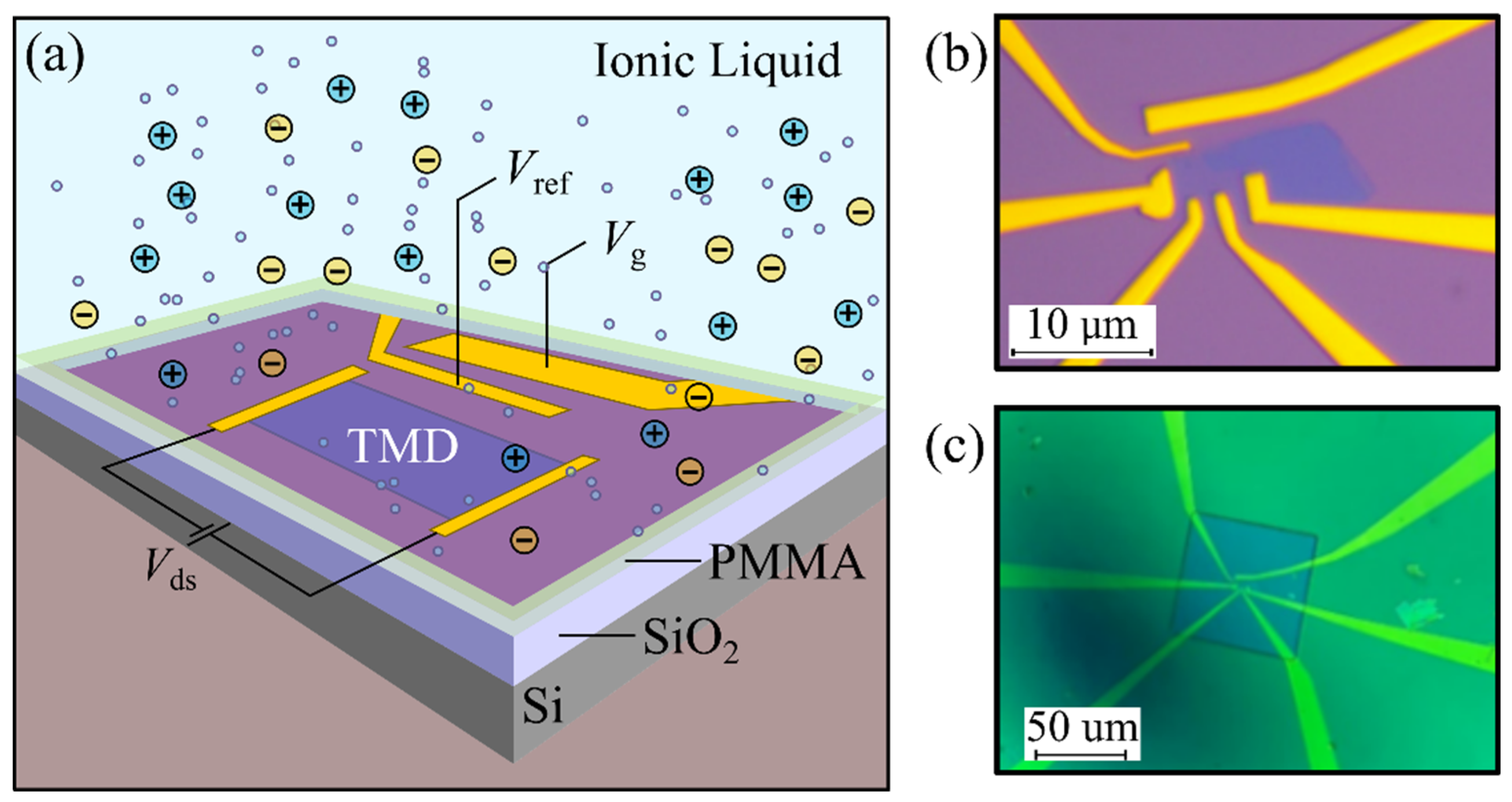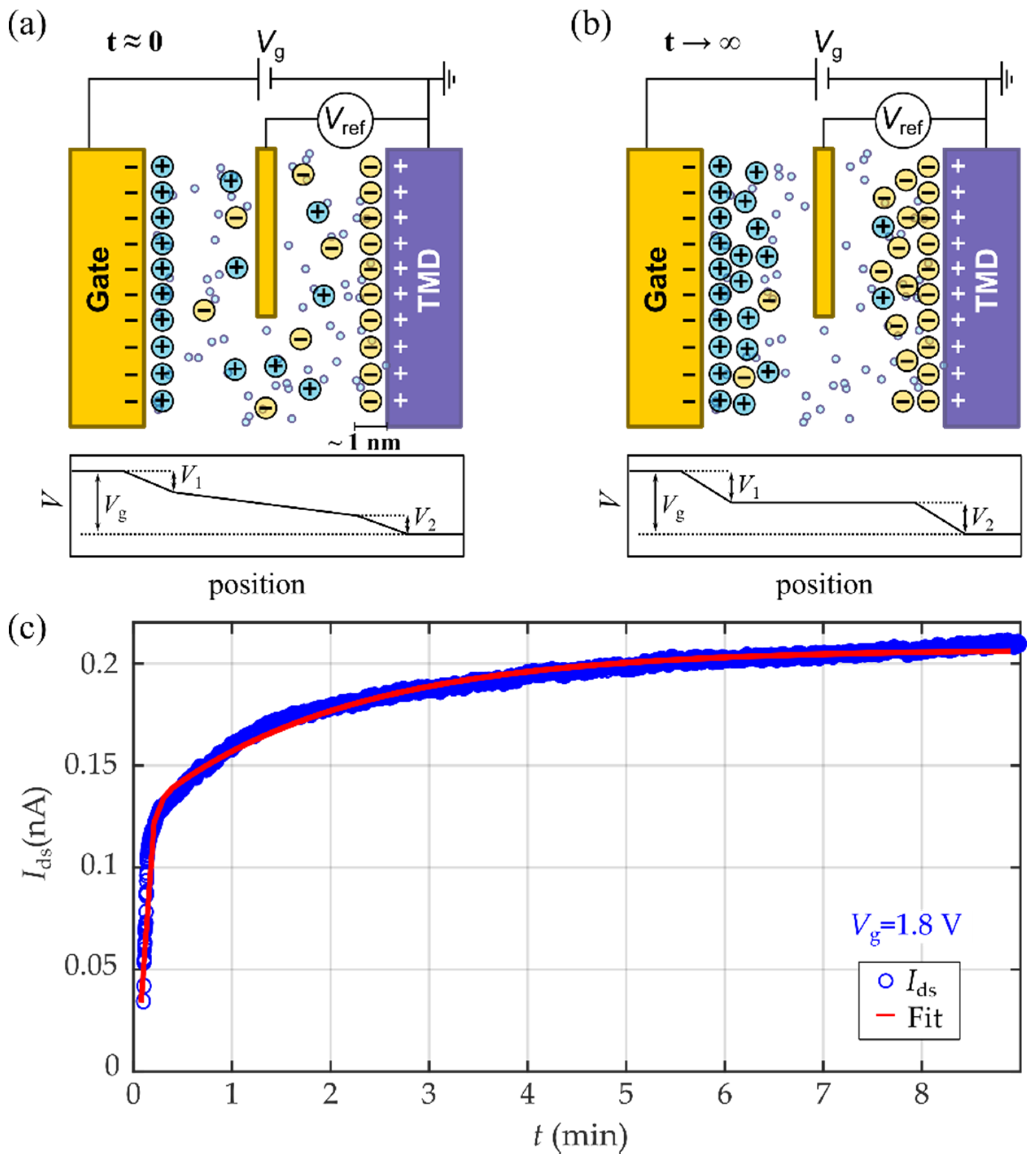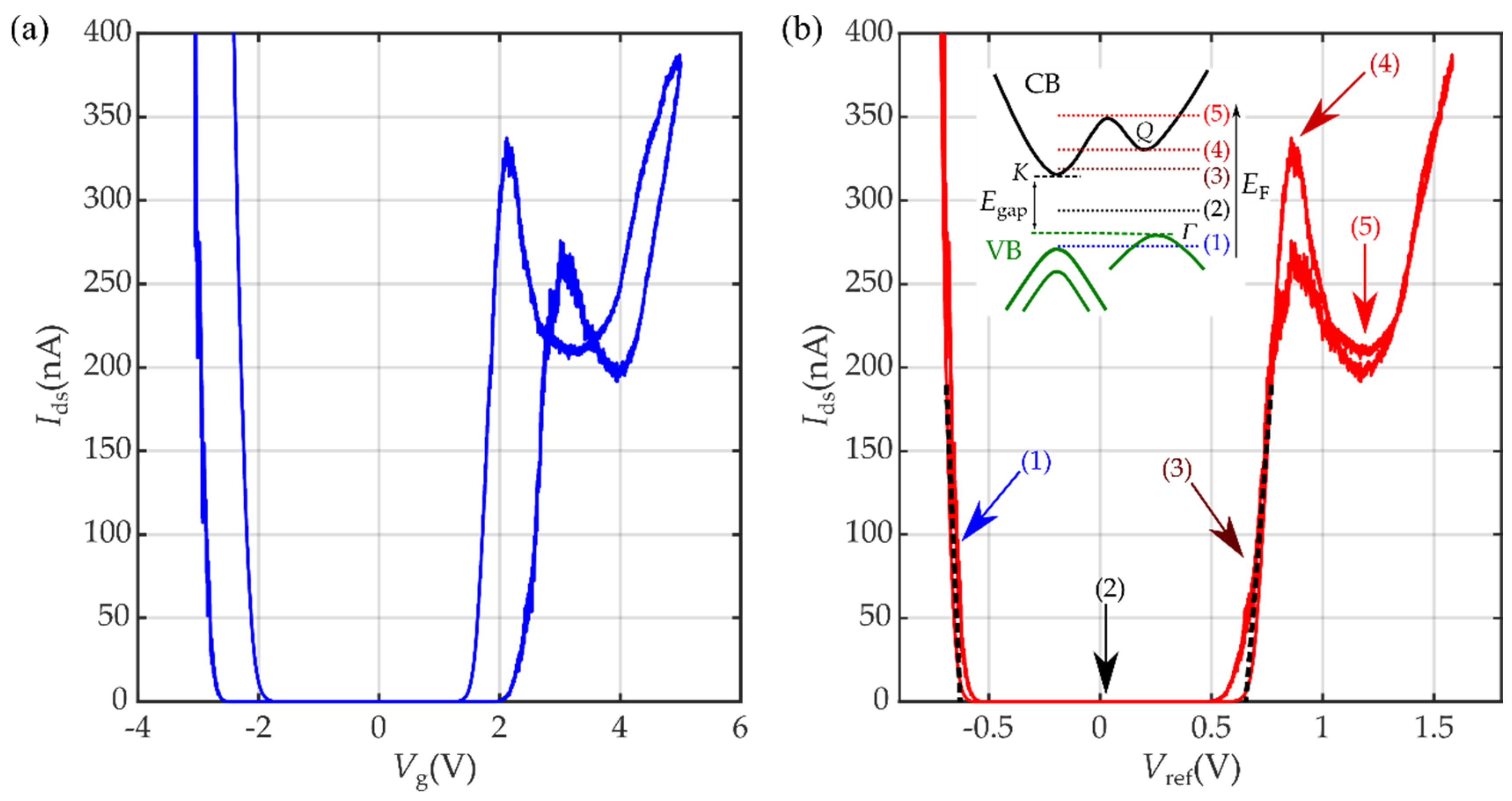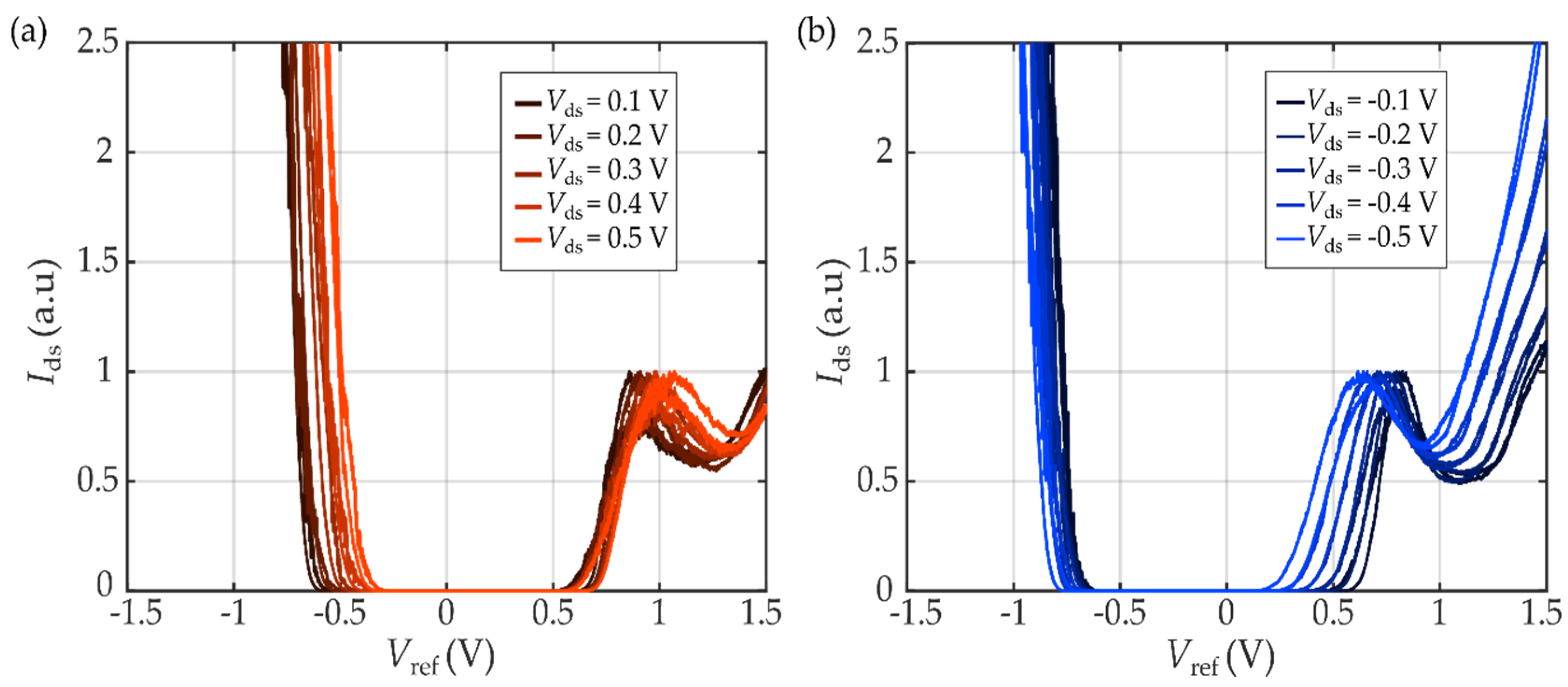Ionic-Liquid Gating in Two-Dimensional TMDs: The Operation Principles and Spectroscopic Capabilities
Abstract
:1. Introduction
2. Results
2.1. Device Fabrication and Geometry
2.2. Basic Device Operation and Doping Mechanisms
2.3. The Need for a Reference Electrode
2.4. Nonmonotonic Behavior in Transfer Characteristics and Estimation of Semiconductor Band Gap
2.5. ILG: A Spectroscopy Technique to Estimate the Semiconductor Band Gap
3. Conclusions
Supplementary Materials
Author Contributions
Funding
Data Availability Statement
Acknowledgments
Conflicts of Interest
References
- Novoselov, K.S.; Mishchenko, A.; Carvalho, A.; Castro Neto, A.H. 2D Materials and van Der Waals Heterostructures. Science 2016, 353, aac9439. [Google Scholar] [CrossRef] [Green Version]
- Radisavljevic, B.; Radenovic, A.; Brivio, J.; Giacometti, V.; Kis, A. Single-Layer MoS2 Transistors. Nat. Nano 2011, 6, 147–150. [Google Scholar] [CrossRef]
- Liu, Y.; Duan, X.; Shin, H.J.; Park, S.; Huang, Y.; Duan, X. Promises and Prospects of Two-Dimensional Transistors. Nature 2021, 591, 43–53. [Google Scholar] [CrossRef] [PubMed]
- Brattain, B.W.H.; Garrett, C.G.B. Experiments on the Interface Hetween Germanium and an Electrolyte. Bell Syst. Tech. J. 1954, 34, 129–176. [Google Scholar] [CrossRef]
- Shimotani, H.; Asanuma, H.; Takeya, J.; Iwasa, Y. Electrolyte-Gated Charge Accumulation in Organic Single Crystals. Appl. Phys. Lett. 2006, 89, 203501. [Google Scholar] [CrossRef]
- Shimotani, H.; Asanuma, H.; Tsukazaki, A.; Ohtomo, A.; Kawasaki, M.; Iwasa, Y. Insulator-to-Metal Transition in ZnO by Electric Double Layer Gating. Appl. Phys. Lett. 2007, 91, 15–18. [Google Scholar] [CrossRef]
- Yuan, H.; Shimotani, H.; Tsukazaki, A.; Ohtomo, A.; Kawasaki, M.; Iwasa, Y. High-Density Carrier Accumulation in ZnO Field-Effect Transistors Gated by Electric Double Layers of Ionic Liquids. Adv. Funct. Mater. 2009, 19, 1046–1053. [Google Scholar] [CrossRef]
- Yuan, H.; Shimotani, H.; Tsukazaki, A.; Ohtomo, A. Hydrogenation-Induced Surface Polarity Recognition and Proton Memory Behavior at Protic-Ionic-Liquid/Oxide Electric-Double-Layer Interfaces. J. Am. Chem. Soc. 2010, 132, 6672–6678. [Google Scholar] [CrossRef]
- Bisri, S.Z.; Shimizu, S.; Nakano, M.; Iwasa, Y. Endeavor of Iontronics: From Fundamentals to Applications of Ion-Controlled Electronics. Adv. Mater. 2017, 29, 1607054. [Google Scholar] [CrossRef]
- Yamada, Y.; Ueno, K.; Fukumura, T.; Yuan, H.T.; Shimotani, H.; Iwasa, Y.; Gu, L.; Tsukimoto, S.; Ikuhara, Y.; Kawasaki, M. Electrically Induced Ferromagnetism at Room Temperature in Cobalt-Doped Titanium Dioxide. Science 2011, 332, 1065–1067. [Google Scholar] [CrossRef]
- Ye, J.T.; Inoue, S.; Kobayashi, K.; Kasahara, Y.; Yuan, H.T.; Shimotani, H.; Iwasa, Y. Liquid-Gated Interface Superconductivity on an Atomically Flat Film. Nat. Mater. 2010, 9, 125–128. [Google Scholar] [CrossRef]
- Kim, S.H.; Hong, K.; Xie, W.; Lee, K.H.; Zhang, S.; Lodge, T.P.; Frisbie, C.D. Electrolyte-Gated Transistors for Organic and Printed Electronics. Adv. Mater. 2013, 25, 1822–1846. [Google Scholar] [CrossRef] [PubMed]
- Xia, B.Y.; Cho, J.H.; Lee, J.; Ruden, P.P.; Frisbie, C.D. Comparison of the Mobility–Carrier Density Relation in Polymer and Single-Crystal Organic Transistors Employing Vacuum and Liquid Gate Dielectrics. Adv. Mater. 2009, 21, 2174–2179. [Google Scholar] [CrossRef]
- Leger, J.; Berggren, M.; Carter, S.; Berggren, M.; Carter, S. Iontronics: Ionic Carriers in Organic Electronic Materials and Devices; CRC Press: Boca Raton, FL, USA, 2016. [Google Scholar]
- You, A.; Be, M.A.Y.; In, I. Electrochemical Carbon Nanotube Field-Effect Transistor. Appl. Phys. Lett. 2007, 78, 1291. [Google Scholar] [CrossRef] [Green Version]
- Lieb, J.; Demontis, V.; Prete, D.; Ercolani, D.; Zannier, V.; Sorba, L.; Ono, S.; Beltram, F.; Sacépé, B.; Rossella, F. Ionic-Liquid Gating of InAs Nanowire-Based Field-Effect Transistors. Adv. Funct. Mater. 2019, 29, 1804378. [Google Scholar] [CrossRef] [Green Version]
- Demontis, V.; Zannier, V.; Sorba, L.; Rossella, F. Surface Nano-Patterning for the Bottom-Up Growth of III-V Semiconductor Nanowire Ordered Arrays. Nanomaterials 2021, 11, 2079. [Google Scholar] [CrossRef]
- Ullah, A.R.; Carrad, D.J.; Krogstrup, P.; Nygård, J.; Micolich, A.P. Near-Thermal Limit Gating in Heavily Doped III-V Semiconductor Nanowires Using Polymer Electrolytes. Phys. Rev. Mater. 2018, 2, 25601. [Google Scholar] [CrossRef] [Green Version]
- Carrad, D.J.; Mostert, A.B.; Ullah, A.R.; Burke, A.M.; Joyce, H.J.; Tan, H.H.; Jagadish, C.; Krogstrup, P.; Nygård, J.; Meredith, P. Hybrid Nanowire Ion-to-Electron Transducers for Integrated Bioelectronic Circuitry. Nano Lett. 2017, 17, 827–833. [Google Scholar] [CrossRef] [Green Version]
- Ueno, K.; Nakamura, S.; Shimotani, H.; Ohtomo, A.; Kimura, N.; Nojima, T.; Aoki, H.; Iwasa, Y.; Kawasaki, M. Electric-Field-Induced Superconductivity in an Insulator. Nat. Mater. 2008, 7, 855–858. [Google Scholar] [CrossRef]
- Ueno, K.; Nakamura, S.; Shimotani, H.; Yuan, H.T.; Kimura, N.; Nojima, T.; Aoki, H.; Iwasa, Y.; Kawasaki, M. Discovery of Superconductivity in KTaO3 by Electrostatic Carrier Doping. Nat. Nanotechnol. 2011, 6, 408–412. [Google Scholar] [CrossRef] [PubMed]
- Fujimoto, T.; Awaga, K. Electric-Double-Layer Field-Effect Transistors with Ionic Liquids. Phys. Chem. Chem. Phys 2013, 15, 8983–9006. [Google Scholar] [CrossRef] [PubMed]
- Yuan, H.T.; Toh, M.; Morimoto, K.; Tan, W.; Wei, F.; Shimotani, H.; Kloc, C.; Iwasa, Y. Liquid-Gated Electric-Double-Layer Transistor on Layered Metal Dichalcogenide, SnS2. Appl. Phys. Lett. 2011, 98, 012102. [Google Scholar] [CrossRef]
- Zhang, Y.; Ye, J.; Matsuhashi, Y.; Iwasa, Y. Ambipolar MoS2 Thin Flake Transistors. Nano Lett. 2012, 12, 1136–1140. [Google Scholar] [CrossRef]
- Ye, J.T.; Zhang, Y.J.; Akashi, R.; Bahramy, M.S.; Arita, R.; Iwasa, Y. Superconducting Dome in a Gate-Tuned Band Insulator. Science 2012, 338, 1193–1196. [Google Scholar] [CrossRef] [PubMed]
- Biscaras, J.; Chen, Z.; Paradisi, A.; Shukla, A. Onset of Two-Dimensional Superconductivity in Space Charge Doped Few-Layer Molybdenum Disulfide. Nat. Commun. 2015, 6, 8826. [Google Scholar] [CrossRef] [Green Version]
- Costanzo, D.; Jo, S.; Berger, H.; Morpurgo, A.F. Gate-Induced Superconductivity in Atomically Thin MoS2 Crystals. Nat. Nanotechnol. 2016, 11, 339–344. [Google Scholar] [CrossRef] [Green Version]
- Costanzo, D.; Zhang, H.; Reddy, B.A.; Berger, H.; Morpurgo, A.F. Tunnelling Spectroscopy of Gate-Induced Superconductivity in MoS2. Nat. Nanotechnol. 2018, 13, 483–488. [Google Scholar] [CrossRef] [Green Version]
- Piatti, E.; De Fazio, D.; Daghero, D.; Tamalampudi, S.R.; Yoon, D.; Ferrari, A.C.; Gonnelli, R.S. Multi-Valley Superconductivity in Ion-Gated MoS2 Layers. Nano Lett. 2018, 18, 4821–4830. [Google Scholar] [CrossRef] [Green Version]
- Lu, J.M.; Zheliuk, O.; Leermakers, I.; Yuan, N.F.Q.; Zeitler, U.; Law, K.T.; Ye, J.T. Evidence for Two-Dimensional Ising Superconductivity in Gated MoS2. Science 2015, 350, 1353–1358. [Google Scholar] [CrossRef] [Green Version]
- Saito, Y.; Nakamura, Y.; Bahramy, M.S.; Kohama, Y.; Ye, J.; Kasahara, Y.; Nakagawa, Y.; Onga, M.; Tokunaga, M.; Nojima, T.; et al. Superconductivity Protected by Spin-Valley Locking in Ion-Gated MoS2. Nat. Phys. 2016, 12, 144–149. [Google Scholar] [CrossRef]
- Dhoot, A.S.; Israel, C.; Moya, X.; Mathur, N.D.; Friend, R.H. Large Electric Field Effect in Electrolyte-Gated Manganites. Phys. Rev. Lett. 2009, 102, 136402. [Google Scholar] [CrossRef]
- Jo, S.; Costanzo, D.; Berger, H.; Morpurgo, A.F. Electrostatically Induced Superconductivity at the Surface of WS2. Nano Lett. 2015, 15, 1197–1202. [Google Scholar] [CrossRef] [PubMed] [Green Version]
- Lu, J.; Zheliuk, O.; Chen, Q.; Leermakers, I.; Hussey, N.E.; Zeitler, U.; Ye, J. Full Superconducting Dome of Strong Ising Protection in Gated Monolayer WS2. Proc. Natl. Acad. Sci. USA 2018, 115, 3551–3556. [Google Scholar] [CrossRef] [PubMed] [Green Version]
- Shi, W.; Ye, J.; Zhang, Y.; Suzuki, R.; Yoshida, M.; Miyazaki, J.; Inoue, N.; Saito, Y.; Iwasa, Y. Superconductivity Series in Transition Metal Dichalcogenides by Ionic Gating. Sci. Rep. 2015, 5, 12534. [Google Scholar] [CrossRef] [PubMed] [Green Version]
- Kouno, S.; Sato, Y.; Katayama, Y.; Ichinose, A.; Asami, D. Superconductivity at 38 K at an Electrochemical Interface between Various Substrates. Sci. Rep. 2018, 8, 14731. [Google Scholar] [CrossRef]
- Zeng, J.; Liu, E.; Fu, Y.; Chen, Z.; Pan, C.; Wang, C.; Wang, M.; Wang, Y.; Xu, K.; Cai, S.; et al. Gate-Induced Interfacial Superconductivity in 1T-SnSe2. Nano Lett. 2018, 18, 1410–1415. [Google Scholar] [CrossRef] [Green Version]
- Zhang, Y.J.; Oka, T.; Suzuki, R.; Ye, J.T.; Iwasa, Y. Electrically Switchable Chiral Light-Emitting Transistor. Science 2014, 344, 725–728. [Google Scholar] [CrossRef]
- Jo, S.; Ubrig, N.; Berger, H.; Kuzmenko, A.B.; Morpurgo, A.F. Mono- and Bilayer WS2 Light-Emitting Transistors. Nano Lett. 2014, 14, 2019–2025. [Google Scholar] [CrossRef] [Green Version]
- Sohier, T.; Ponomarev, E.; Gibertini, M.; Berger, H.; Marzari, N.; Ubrig, N.; Morpurgo, A.F. Enhanced Electron-Phonon Interaction in Multivalley Materials. Phys. Rev. X 2019, 9, 31019. [Google Scholar] [CrossRef] [Green Version]
- Braga, D.; Gutiérrez Lezama, I.; Berger, H.; Morpurgo, A.F. Quantitative Determination of the Band Gap of WS2 with Ambipolar Ionic Liquid-Gated Transistors. Nano Lett. 2012, 12, 5218–5223. [Google Scholar] [CrossRef] [Green Version]
- Lezama, I.G.; Ubaldini, A.; Longobardi, M.; Giannini, E.; Renner, C.; Kuzmenko, A.B.; Morpurgo, A.F. Surface Transport and Band Gap Structure of Exfoliated. 2D Mater. 2014, 1, 021002. [Google Scholar] [CrossRef] [Green Version]
- Berger, H.; Ponomarev, E.; Ubrig, N.; Gutie, I.; Morpurgo, A.F. Semiconducting van Der Waals Interfaces as Arti Fi Cial Semiconductors. Nano Lett. 2018, 18, 5146–5152. [Google Scholar] [CrossRef]
- Waelchli, A.; Scarfato, A.; Ubrig, N.; Renner, C.; Morpurgo, A.F. Hole Transport in Exfoliated Monolayer MoS2. ACS Nano 2018, 12, 2669–2676. [Google Scholar] [CrossRef] [Green Version]
- Oldham, K.B. A Gouy-Chapman-Stern Model of the Double Layer at a (Metal)/(Ionic Liquid) Interface. J. Electroanal. Chem. 2008, 613, 131–138. [Google Scholar] [CrossRef]
- Lee, J.; Kaake, L.G.; Cho, J.H.; Zhu, X.; Lodge, T.P.; Frisbie, C.D. Ion Gel-Gated Polymer Thin-Film Transistors: Operating Mechanism and Characterization of Gate Dielectric Capacitance, Switching Speed, and Stability. J. Phys. Chem. C 2009, 113, 8972–8981. [Google Scholar] [CrossRef]
- Li, M.; Han, W.; Jiang, X.; Jeong, J.; Samant, M.G.; Parkin, S.S.P. Suppression of Ionic Liquid Gate-Induced Metallization of SrTiO3(001) by Oxygen. Nano Lett. 2013, 13, 4675–4678. [Google Scholar] [CrossRef] [PubMed]
- Jeong, J.; Aetukuri, N.; Graf, T.; Schladt, T.D.; Samant, M.G.; Parkin, S.S.P. Suppression of Metal-Insulator Transition in VO2 by Electric Field-Induced Oxygen Vacancy Formation. Science 2013, 339, 1402–1405. [Google Scholar] [CrossRef] [PubMed]
- Perez-Muñoz, A.M.; Schio, P.; Poloni, R.; Fernandez-Martinez, A.; Rivera-Calzada, A.; Cezar, J.C.; Salas-Colera, E.; Castro, G.R.; Kinney, J.; Leon, C.; et al. In Operando Evidence of Deoxygenation in Ionic Liquid Gating of YBa2Cu3O7-X. Proc. Natl. Acad. Sci. USA 2017, 114, 215–220. [Google Scholar] [CrossRef] [Green Version]
- Zhang, H.; Berthod, C.; Berger, H.; Giamarchi, T.; Morpurgo, A.F. Band Filling and Cross Quantum Capacitance in Ion-Gated Semiconducting Transition Metal Dichalcogenide Monolayers. Nano Lett. 2019, 19, 8836–8845. [Google Scholar] [CrossRef] [Green Version]
- Zhao, W.; Ribeiro, R.M.; Toh, M.; Carvalho, A.; Kloc, C.; Castro Neto, A.H.; Eda, G. Origin of Indirect Optical Transitions in Few-Layer MoS2, WS2, and WSe2. Nano Lett. 2013, 13, 5627–5634. [Google Scholar] [CrossRef] [Green Version]
- Poellmann, C.; Steinleitner, P.; Leierseder, U.; Nagler, P.; Plechinger, G.; Porer, M.; Bratschitsch, R.; Schüller, C.; Korn, T.; Huber, R. Resonant Internal Quantum Transitions and Femtosecond Radiative Decay of Excitons in Monolayer WSe2. Nat. Mater. 2015, 14, 889–893. [Google Scholar] [CrossRef]
- Hill, H.M.; Rigosi, A.F.; Roquelet, C.; Chernikov, A.; Berkelbach, T.C.; Reichman, D.R.; Hybertsen, M.S.; Brus, L.E.; Heinz, T.F. Observation of Excitonic Rydberg States in Monolayer MoS2 and WS2 by Photoluminescence Excitation Spectroscopy. Nano Lett. 2015, 15, 2992–2997. [Google Scholar] [CrossRef] [PubMed]
- Raja, A.; Chaves, A.; Yu, J.; Arefe, G.; Hill, H.M.; Rigosi, A.F.; Berkelbach, T.C.; Nagler, P.; Schüller, C.; Korn, T.; et al. Coulomb Engineering of the Bandgap and Excitons in Two-Dimensional Materials. Nat. Commun. 2017, 8, 15251. [Google Scholar] [CrossRef] [Green Version]
- Zhang, C.; Johnson, A.; Hsu, C.L.; Li, L.J.; Shih, C.K. Direct Imaging of Band Profile in Single Layer MoS2 on Graphite: Quasiparticle Energy Gap, Metallic Edge States, and Edge Band Bending. Nano Lett. 2014, 14, 2443–2447. [Google Scholar] [CrossRef] [PubMed] [Green Version]
- Chiu, M.H.; Zhang, C.; Shiu, H.W.; Chuu, C.P.; Chen, C.H.; Chang, C.Y.S.; Chen, C.H.; Chou, M.Y.; Shih, C.K.; Li, L.J. Determination of Band Alignment in the Single-Layer MoS2 WSe2 Heterojunction. Nat. Commun. 2015, 6, 7666. [Google Scholar] [CrossRef] [Green Version]
- Cucchi, I.; Gutiérrez-Lezama, I.; Cappelli, E.; Walker, S.M.K.; Bruno, F.Y.; Tenasini, G.; Wang, L.; Ubrig, N.; Barreteau, C.; Giannini, E.; et al. Microfocus Laser-Angle-Resolved Photoemission on Encapsulated Mono-, Bi-, and Few-Layer 1T′-WTe2. Nano Lett. 2019, 19, 554–560. [Google Scholar] [CrossRef] [Green Version]
- Hamer, M.J.; Zultak, J.; Tyurnina, A.V.; Zólyomi, V.; Terry, D.; Barinov, A.; Garner, A.; Donoghue, J.; Rooney, A.P.; Kandyba, V.; et al. Indirect to Direct Gap Crossover in Two-Dimensional InSe Revealed by Angle-Resolved Photoemission Spectroscopy. ACS Nano 2019, 13, 2136–2142. [Google Scholar] [CrossRef] [Green Version]
- Gutiérrez-Lezama, I.; Ubrig, N.; Ponomarev, E.; Morpurgo, A.F. Ionic Gate Spectroscopy of 2D Semiconductors. Nat. Rev. Phys. 2021, 3, 508–519. [Google Scholar] [CrossRef]
- Desai, S.B.; Seol, G.; Kang, J.S.; Fang, H.; Battaglia, C.; Kapadia, R.; Ager, J.W.; Guo, J.; Javey, A. Strain-Induced Indirect to Direct Bandgap Transition in Multilayer WSe2. Nano Lett. 2014, 14, 4592–4597. [Google Scholar] [CrossRef]
- Tang, N.; Du, C.; Wang, Q.; Xu, H. Strain Engineering in Bilayer WSe2 over a Large Strain Range. Microelectron. Eng. 2020, 223, 111202. [Google Scholar] [CrossRef]
- Kumar, S.; Kaczmarczyk, A.; Gerardot, B.D. Strain-Induced Spatial and Spectral Isolation of Quantum Emitters in Mono- and Bilayer WSe2. Nano Lett. 2015, 15, 7567–7573. [Google Scholar] [CrossRef] [PubMed] [Green Version]




Publisher’s Note: MDPI stays neutral with regard to jurisdictional claims in published maps and institutional affiliations. |
© 2021 by the authors. Licensee MDPI, Basel, Switzerland. This article is an open access article distributed under the terms and conditions of the Creative Commons Attribution (CC BY) license (https://creativecommons.org/licenses/by/4.0/).
Share and Cite
Vaquero, D.; Clericò, V.; Salvador-Sánchez, J.; Quereda, J.; Diez, E.; Pérez-Muñoz, A.M. Ionic-Liquid Gating in Two-Dimensional TMDs: The Operation Principles and Spectroscopic Capabilities. Micromachines 2021, 12, 1576. https://doi.org/10.3390/mi12121576
Vaquero D, Clericò V, Salvador-Sánchez J, Quereda J, Diez E, Pérez-Muñoz AM. Ionic-Liquid Gating in Two-Dimensional TMDs: The Operation Principles and Spectroscopic Capabilities. Micromachines. 2021; 12(12):1576. https://doi.org/10.3390/mi12121576
Chicago/Turabian StyleVaquero, Daniel, Vito Clericò, Juan Salvador-Sánchez, Jorge Quereda, Enrique Diez, and Ana M. Pérez-Muñoz. 2021. "Ionic-Liquid Gating in Two-Dimensional TMDs: The Operation Principles and Spectroscopic Capabilities" Micromachines 12, no. 12: 1576. https://doi.org/10.3390/mi12121576





